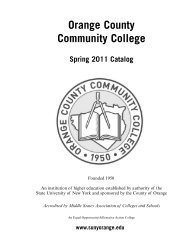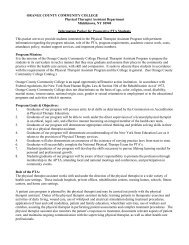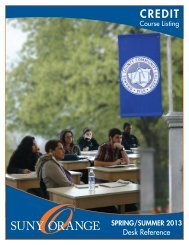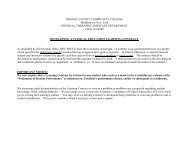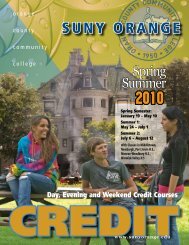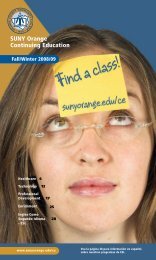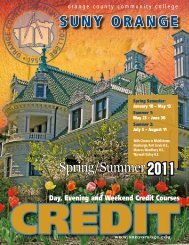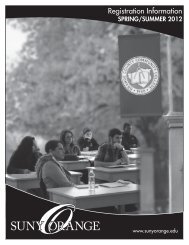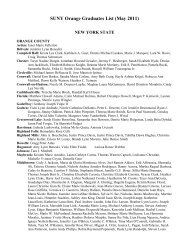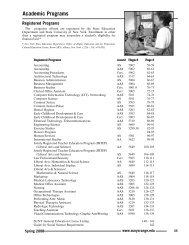Style Guide - SUNY Orange
Style Guide - SUNY Orange
Style Guide - SUNY Orange
Create successful ePaper yourself
Turn your PDF publications into a flip-book with our unique Google optimized e-Paper software.
If an individual’s age is used, set it off by commas: Murphy Brown, 48, Washington, DC, was present. Again, the use of the<br />
word “of” will eliminate the need for some of these commas.<br />
With Yes and No: Yes, I will be there.<br />
Confused? Consult the <strong>Guide</strong> to Pronunciation section in the back of Webster’s New World Dictionary<br />
DATES AND TIME<br />
Always use Arabic figures for dates, without st, nd, rd or th: November 1, 1998.<br />
Use figures for times except for noon and midnight. Use a colon to separate hours from minutes. It isn’t necessary to<br />
indicate a time “on the hour” by typing :00. Avoid redundancies like 12 noon; 10 p.m. tonight.<br />
If the current year is implied, it isn’t necessary to write it out. Use the year in text if it refers to past or future years. Our<br />
January 2000 meeting. Our December 20 party.<br />
Lowercase a.m. and p.m., with periods: 9:30 a.m., 1 p.m., noon.<br />
Spaces between the hyphens with times: 9:30 a.m. – 3 p.m.<br />
Hyphens<br />
Use hyphens to join words together when they are needed to avoid ambiguity or to form a single idea from two or more<br />
words and modify a noun: First-Year Experience, a well-known person, a full-time employee.<br />
Do not hyphenate when they come after a noun: That experience happened in his first year. He is well known. She works full<br />
time. In some cases hyphens are used with prefixes or suffixes.<br />
Do not use a hyphen between adverbs ending in -ly and the adjectives they modify: highly qualified faculty, fully informed<br />
student body, warmly receptive audience.<br />
If in doubt over whether or not a hyphen should be used in a particular word, please refer to Webster’s New World Dictionary<br />
or the Associated Press <strong>Style</strong>book.<br />
PHONE NUMBERS<br />
In general, the college will be looking to achieve consistency with the following format: (845) 346-6222.<br />
Quotations<br />
Commas and periods always go inside quotation marks, while semicolons and colons always go outside quotation marks<br />
or parentheses.<br />
Exclamation points and question marks go inside the quotation marks when they are part of the quoted matter. Otherwise,<br />
they go outside. All of the following are correct:<br />
“Our five-year plan will require some modification,” said the president, “but on the whole I feel it is sound.”<br />
The president said the five-year plan needs “a few minor adjustments”; however, he did not call for wholesale changes.<br />
The five-year plan mandates “quality first!”<br />
The five-year plan asks, “Where do we want to go and how shall we proceed?”<br />
What did the dean mean when he said, “Your portion of the plan is incomplete”?<br />
Use single quotes inside of double quotes when dealing with layered quotations. The student asked, “Are we going to hear<br />
the “you need to arrive to class on time’ speech again today?”<br />
<strong>SUNY</strong> <strong>Orange</strong> <strong>Style</strong> <strong>Guide</strong><br />
17




